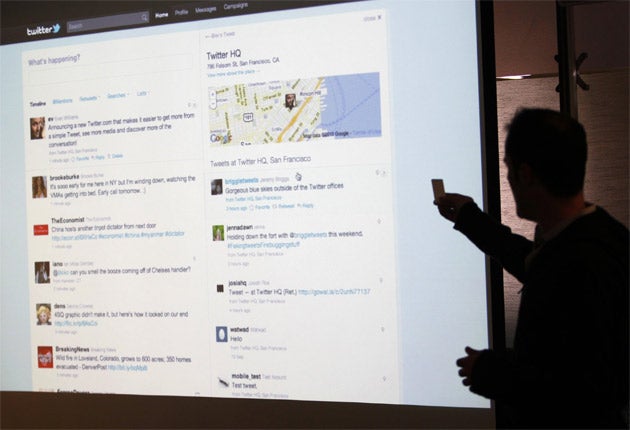Looks are everything for Twitter as it goes in search of profits

Your support helps us to tell the story
From reproductive rights to climate change to Big Tech, The Independent is on the ground when the story is developing. Whether it's investigating the financials of Elon Musk's pro-Trump PAC or producing our latest documentary, 'The A Word', which shines a light on the American women fighting for reproductive rights, we know how important it is to parse out the facts from the messaging.
At such a critical moment in US history, we need reporters on the ground. Your donation allows us to keep sending journalists to speak to both sides of the story.
The Independent is trusted by Americans across the entire political spectrum. And unlike many other quality news outlets, we choose not to lock Americans out of our reporting and analysis with paywalls. We believe quality journalism should be available to everyone, paid for by those who can afford it.
Your support makes all the difference.More than 190 million visitors per month isn't bad for a web phenomenon that is widely criticised for being inconsequential, ephemeral and narcissistic. But despite the huge popularity of Twitter, which scores 370,000 new users every day, making money out of its customers has proved more of a challenge – until yesterday, when the social network unveiled a new look that will have advertisers salivating.
The changes, which will hit all users' screens over the next few weeks, see a two-pane layout replacing the straightforward list of tweets; the second pane can perform a number of functions, but the most significant is displaying media content relating to that tweet without the user having to visit another website.
Yesterday's launch was, according to Twitter co-founder Evan Williams, "not for the sake of advertisers". But the redesign will excite marketeers traditionally inhibited by the site's stripped-back look. Twitter may finally be on the brink of demonstrating why $160m [£103m] of venture capital has been ploughed into the company so far.
Twitter's popularity – much like Google's – has been built on its simplicity. You post a message, or a link to a website, and anyone bothering to pay attention will see it. If they want to, they can reply. Easy. But as Twitter has grown and new uses have been found for it by individuals and organisations, there has been a heavy reliance on third-party services that help to organise and display Twitter-related data in more user-friendly ways.
Applications such as TweetDeck or Seesmic help fit more information on one screen; it could be an image-hosting service like yFrog or Twitpic; or devices that shortened web addresses such as is.gd that help squeeze long URLs into Twitter's 140-character limit. In effect, a whole industry has grown up around enhancing Twitter and addressing its shortcomings. Williams himself admitted to shortcomings at yesterday's launch, and this revamp is a bold attempt to persuade the estimated 22 per cent of users who tweet without visiting the site itself that it is time to come back.
No wonder advertisers are eager; thus far, marketing messages on the service have been restricted to "promoted tweets" (the opportunity for a company's tweet to appear at the top of Twitter search results) and "sponsored trends" (corporate branding of a topic that's getting a lot of attention). Even these have been shown to be powerful; Coca-Cola's recent foray into sponsored trends saw them achieve 86 million page impressions in 24 hours.
Twitter users are regarded as less passive than the average web user, and with more screen "real estate" now available to advertisers, their engagement is predicted to become more intense.
As the new-look Twitter gains traffic and collects more data about our clicking habits and interests, it will become even more valuable in the corporate world as advertisements can be targeted at users more specifically. The only danger Twitter faces is the risk of upsetting a significant proportion of its users who aren't concerned about commercial pressures on the company, and would rather have an ad-free experience.
Facebook's past blunders in particular have shown that our tolerance of prominent marketing messages can be low. Twitter has always prided itself on a gently-gently approach; the new-look site will be introduced slowly, with the opportunity to switch to the old interface if we wish. But a Twitter service that's so light on advertising can't last for ever; after all, a business without an income isn't a business at all.
Join our commenting forum
Join thought-provoking conversations, follow other Independent readers and see their replies
Comments